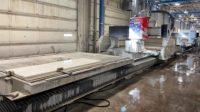
Ghirardi Marmi srl, a family-run stone business that has been in operation since 1938, currently produces Brescia marble from its quarry that was opened in 1969.
Sitting at the foot of the Alps is Brescia, an Italian city that has a rich history in stone quarrying. Part of Italy’s Lombardy region, the area is home to 55 active sites -- including one owned and operated by Marmi Ghirardi srl, a family business founded in 1938.
“After World War II, the town was destroyed, and people left to find work,” explained Giuliano Ghirardi, geologist. “The quarries allowed the life of the town to succeed.” Today, there are approximately 800 workers employed in all of the quarries throughout Brescia.
Ghirardi went on to say that about 200 million years ago, a geological platform was developed, and some of the quarry layers in the bench contained many fossils. Between the layers of stone, there is a clay layer. “From a geological standpoint, it is an African platform,” he said.
The stone found in the Brescia quarries is a sedimentary limestone. “It is called a marble because it is a hard limestone that can be polished,” explained Ghirardi, adding that at the beginning of the 20th century, Brescia marble was being used for projects around the world. “In 1911, some projects in California used Brescia marble.”
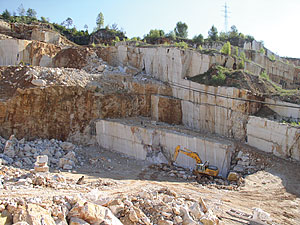
The quarry, which sits on approximately 15 acres of land, produces two kinds of stone. Botticino Florito is light beige in color and mostly used for interiors. Semi Classico has some veining, and it is more yellowish in color. It can be used for exterior applications and flooring.
On average, only 25% of the marble extracted from the site is used for fabrication. Blocks measure roughly 9 to 10 x 5 to 6 feet, and can weigh as much as 24 to 30 tons each. A total of 95% of the blocks are cut into slabs with thicknesses of 2 and 3 cm. The rest of the blocks are utilized for three-dimensional stone pieces.
According to Ghirardi, block sales comprise 80% of the company’s income. At the time of Stone World’s visit, which was during Marmomacc 2010, the company reported that over the four days of the stone exhibition, approximately 100 customers would come to visit the quarry to buy blocks.
The other 75% of material taken from the quarry is by-products that serve several purposes. The material is often used for house foundations, can be crushed and applied as gravel on roads or other applications such as aggregate.

A diamond wire saw is used to free stone from the quarry wall. On average, 13 to 20 square feet can be cut in an hour.
Extracting the stone
A hydraulic hammer is used to drill holes in the bench that do not exceed 3 inches in diameter. Once the hole is drilled, diamond wire is put inside to cut the bench free from the quarry wall. On average, 13 to 20 square feet can be cut in an hour.A water bag is placed between the bench and quarry wall, and as the water bag fills up, the pressure splits the bench free. Backhoes then push it away from the quarry face. About 95 to 99% of the water used during the quarrying process is recycled, according to Marmi Ghirardi.
In addition to the quarrying equipment, there are two Pellegrini diamond wire saws on site to trim blocks. The blocks are then loaded on to flatbeds and taken to Marmi Ghirardi’s processing plant.
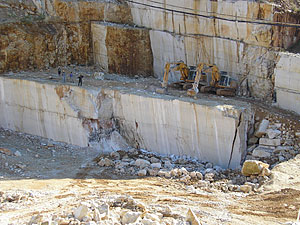
(This picture and the next) A water bag is placed between the bench and quarry wall, and as the water bag fills up, the pressure splits the bench free and backhoes push it away from the quarry face.
The plant
Not far from the quarry site is Ghirardi Marmi’s fabrication operation. A gangsaw plant houses BM gangsaws that can hold up to 80 blades. This is where the blocks are cut into slabs. It is also equipped with a BM mono-blade block cutter.In another building, a host of machinery is in place to cut and finish stonework . In addition to slabs and tile, Ghirardi Marmi also specializes in three-dimensional architectural pieces.
Among the equipment in the processing plant are a Terzago Tofren saw, a GMM Eura 35 bed polisher, a series of bridge saws, hand polishers and line polishers, an Omega 100 and an Edilex automatic edge polishers -- both from Comandulli, an Intermac CNC stoneworking machine center, a Thibaut bed polisher and multi-axis saws from Donatoni.
At the time of Stone World’s visit, the company was working on several mausoleum projects for the U.S. “We number each piece to specify the location,” explained Ghirardi, adding that the mausoleum was made of Brescia Lorado Classico from the company’s own quarry.
Ghirardi Marmi also displayed a mock-up of a Mario Botta project in Italy that was featuring Botticino marble. “It shows the symmetry side of his work,” said Ghirardi.
In addition to the Brescia quarry, Ghirardi Marmi also owns a quarry in South Africa.
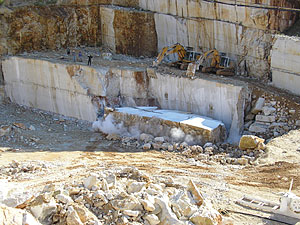
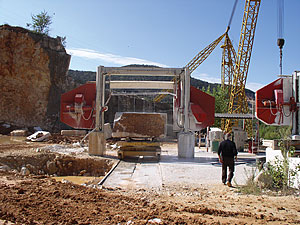
Two Pellegrini diamond wire saws are on site to trim blocks.
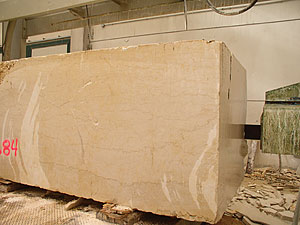
Blocks measure roughly 9 to 10 x 5 to 6 feet, and can weigh as much as 24 to 30 tons each.
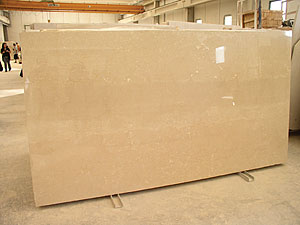
A total of 95% of the blocks are cut into slabs with thicknesses of 2 and 3 cm.
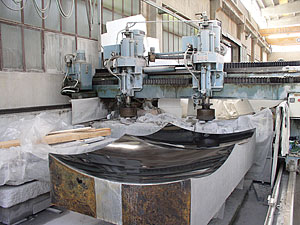
A Thibaut bed polisher is in place at the processing plant to create intricate architectural pieces in stone.
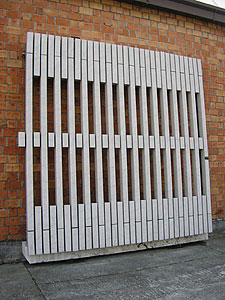
At the time of Stone World’s visit, a mock-up was visible of a Mario Botta project in Italy that was featuring Botticino marble. “It shows the symmetry side of his work,” said Giuliano Ghirardi.

